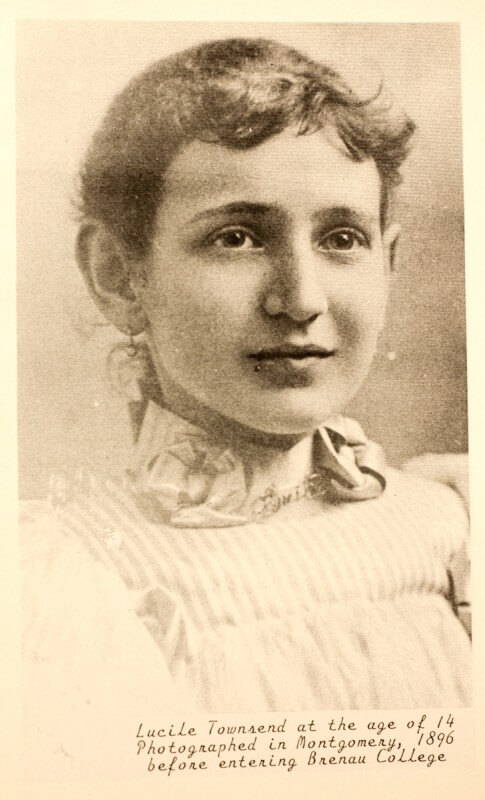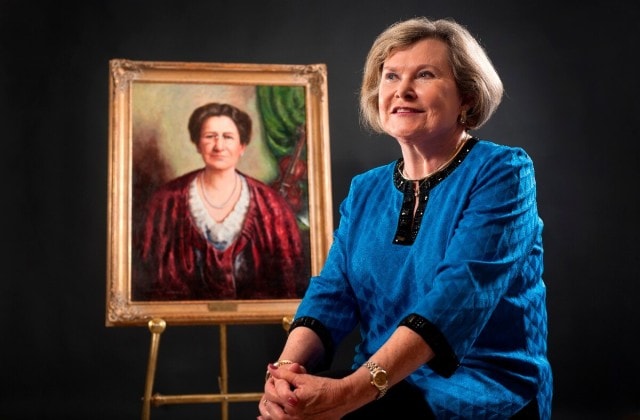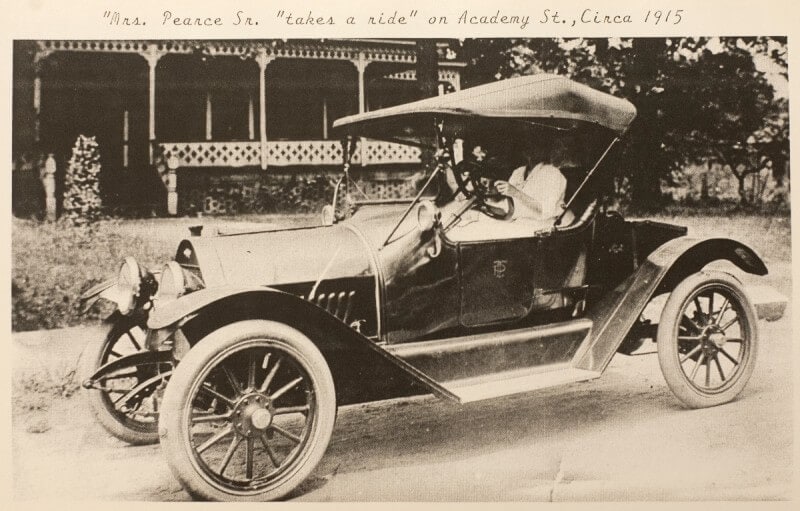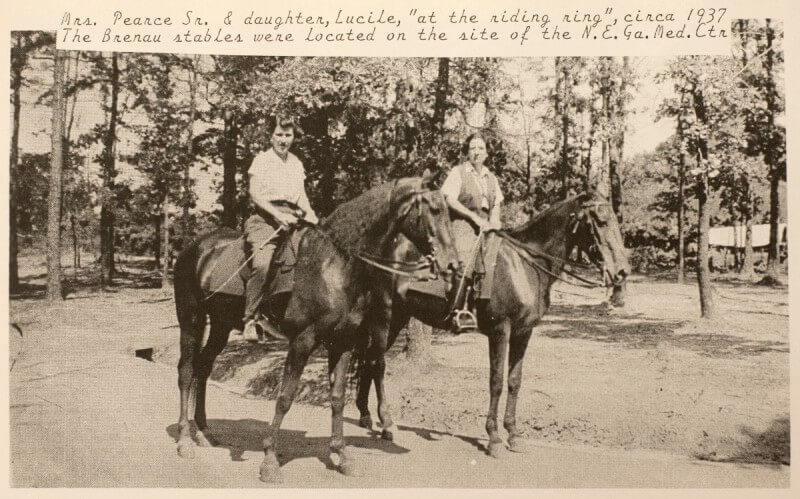The Second President Pearce
Lucile Townsend Pearce was not the typical Southern belle of the early 1900s. More at home on her horse than at a ball, she was demonstrably uncomfortable with the role society had created for women. Although she never held the top title as the university’s chief executive, she definitely shaped its evolution in the first half of the 20th century.
By Mitch Clark
 As a young student at Brenau, Alabama-born Lucile Townsend seemed to hate that single women must be chaperoned when they went into town. Later, after she married Haywood Jefferson Pearce, the college’s president, she used her influence to make changes, big and small, that shape the university still today.
As a young student at Brenau, Alabama-born Lucile Townsend seemed to hate that single women must be chaperoned when they went into town. Later, after she married Haywood Jefferson Pearce, the college’s president, she used her influence to make changes, big and small, that shape the university still today.
She proudly owned a car at a time when virtually no female drove themselves. Family members say she almost always wore her riding habit and boots, even to vespers when she donned her gown over the outdoor attire.
“She wasn’t a conformist,” Brenau Trustee Sissy Lawson, a granddaughter who still lives in Gainesville, says with a laugh. “I don’t think she was held in very high esteem by the Gainesville society ladies.”
Despite evidence that she was a significant shaper of the college, Lucile Townsend Pearce remains very much an enigma. Much of the written history of the university focuses on her husband. Very little is available about her. Her family suspects this is because she didn’t seek notoriety.
It is clear, however, that she played a major role in her husband’s decisions, especially in the areas of the fine arts and physical education. After her husband died in 1943 she served as the chairman of a committee that ran the college for nearly two years. Many believe she was the de facto president during those years in which her efforts helped the school erase a large debt, regain accreditation and increase enrollment.
“Lucile really tried to hold the college together,” says Kathy Amos, the director of Brenau’s Center for Lifetime Study who has researched the early days of the college. “She was a really powerful woman who shaped what the school would become. She’s responsible for the fine arts reputation of this university.”
In 1984, Lawson’s cousin, Bill Adams, wrote a book for the family that detailed the life and accomplishments of Haywood Jefferson and Lucile Pearce. Even that book, family and others concede, does not answer all the questions. “When you look at Brenau history, I’m not sure Lucile Pearce ever wanted to be in the limelight,” says former Brenau President Jack Burd.
Music and Horses
Lucile Townsend was born on July 8, 1883, to the Rev. George W. Townsend, a Confederate War veteran and attorney who later became a minister, and the former Emily Alsop. The family lived on a plantation in Pine Level, Ala., just north of Montgomery, where young Lucile developed a passion for music and horses, loves that would help her make her mark years later.
When she was 14, Lucile enrolled at Brenau, which was then called the Georgia Female Seminary and Conservatory of Music. During her time at the school, she furthered her musical talent as a member of the Violin Club. She was also active in the Croquet Club and the Sewing Club, and was treasurer of her senior class, according to the 1900 Bubbles, the school’s first issue of its first yearbook.
She wrote the introduction to the senior section of the yearbook, showing a self-deprecating and humorous style: “Our relation to the faculty has ever been most pleasant – mixed with just enough of the unpleasant to make life spicy…. One thorn of which the writer herself has a feeling remembrance is the awful psychology examinations, which kept her writing, with one or two others who were slow writers, and still slower thinkers, until the ‘wee small hours.’”
She graduated with honors in 1900, the year Haywood Jefferson Pearce renamed the school Brenau.
Pearce had come to Gainesville in 1893, when he purchased a one-half interest in the school from Azor Van Hoose. Over the years, Pearce would have several partners, as well as periods of time during which he was the sole owner of the school.
The story of the courtship of Lucile Townsend and Haywood Jefferson Pearce remains a mystery. Family members aren’t sure when they met and started dating. Pearce, 12 years her elder, had been married earlier to the former Mamie Mathews of Columbus, Ga., and they had four children. But the first wife died in 1897, the year Lucile came to Gainesville.
Pearce and Lucile were married in 1904 in New York City, where her parents had relocated. Following the wedding, Pearce took a leave of absence to pursue in doctorate in Germany, and the couple spent three years in Europe. While her husband pursued his degree, Lucile Pearce studied music, and she often held violin recitals. Her wedding announcement in the newspaper described her “one of the most accomplished violinists in the South.”
“I think she wanted a career in music,” says Gayle P. Dunlap, another grandson who lives in Gainesville. “But she was never able to pursue it. She must have been the driving force behind the music department. They were able to attract people who were really world-renowned, and I think that came from her connections.”
The Pearces returned to Brenau in 1907. It wasn’t long before Lucile began to make her mark. She is believed to be the first woman in Northeast Georgia to own a car, including a 1915 Ford Model T.
“She was very independent,” Dunlap says. “She always had her car, and she didn’t let anyone else drive it.”
The Pearces had two daughters: Lucile, named for her mother, and Emily, named for her grandmother. The children took up a good bit of her time, but it didn’t stop her from assisting her husband, who by 1910 had once again gained full ownership of the college.
A talented artist in her own right, Lucile Pearce served as first violinist in the school orchestra. In her role as the president’s wife, she spent much time building up the music and arts departments. During this period, the college gained national and international recognition for its fine arts programs.
Haywood Jefferson Pearce’s office was on the third floor above what is now Pearce Auditorium. From his office there was a staircase to a small fourth-floor room. It is believed he built that room as Lucile Pearce’s private space, where she would practice the violin, read or just have time alone. She would also host intimate recitals there for some of the better music students.
At some point, the staircase was removed, making access the room nearly impossible. Amos, however, has seen it and says it offers one of the most magnificent views of the campus.
Lucile was also an accomplished horsewoman, having fallen in love with riding back home in Alabama. There were stables on campus, now renovated for other uses, but she used her family money to buy a large tract of land adjacent to the campus as a place for her horses. At this time, Brenau extended from the present campus to Spring Street, Park Hill Drive and Lakeshore Drive as the outer boundary. The property where Northeast Georgia Medical Center sits today was a stable where as many as 50 horses were kept.
The area was also full of gardens, trails and Japanese-style pagodas. In 1920, Lucile Pearce encouraged her husband to establish Camp Takeda, a summer camp for girls.
She originated the idea of using covered wagons, drawn by the college’s horses, to meet the girls at the train depot for a parade to the camp. That included not just campers, but Brenau students, too.
“Camp Takeda was at Lucile’s insistence,” Amos says. “She wanted the young girls to be able to get outside and ride or be on one of the lakes. She was trying to make it a less-sheltered life for the girls.”
“The girls sometimes referred to (the school) as a prison,” says Burd. “When they went to eat, they were assigned seats and a faculty member sat with them to teach them manners.” When the girls went to town, they had to have a chaperone. The stables on the Townsend land was the only place the women could go without a chaperone, and they became very popular as a result.
In 1917, Pearce began to realize that he could not lead the college alone. He made arrangements to turn the college over to a board of trustees on the condition that it raise a perpetual endowment. The board, which included Lucile Pearce and Haywood Jefferson Pearce Jr., the president’s son from his first marriage, gained full control of the college on Feb. 1, 1928, when the trustees met Pearce’s endowment goal.
“Brenau had always been the ‘family business’,” says Burd. “Pearce ran the school to make money, and the family lived pretty well. Only when it became necessary from a financial standpoint was he willing to turn it over to a board.”
Line of Succession
Although Pearce’s namesake son was in the ownership and administrative mix, and arguably the heir-apparent, he had set out to make his own name as a history professor at Emory University in Atlanta. However, he was involved in the a controversial era of Brenau history that began in 1937. That date marked the arrival of the first of “The Dare Stones” on the Brenau campus. (Read more about the stones in the story Brenau’s Pet Rocks).
Purported to solve the centuries-old mystery of what happened to North Carolina’s “Lost Colony” of Roanoke, the stones first were offered to Emory, which declined to accept them. Pearce Jr. brought them to Brenau. The short version of the story is that Pearce Sr. fully embraced them and, after loudly trumpeting their value as monumentally significant artifacts, he, his highly regarded historian son and the college were embarrassed by the 1941 denouement of the stones as fakes in a national magazine.
Lucile had a role in the saga, too. As the story goes, one of the purveyors of the stones threatened somehow to blackmail the Pearces if they did not pay him more money. Since Lucile was the only one the man would talk to, she got in her car, drove to the man’s house and “straightened things out.”
Although neither Pearce was ever implicated in any fraud, the Pearce family was “very much embarrassed by it,” Lawson says. “They never shared anything about it. It was never discussed.”
Running the College
On May 1, 1943, Haywood Jefferson Pearce died. For two years, until Josiah Crudup was named president by the Board of Trustees, an executive committee ran the college. The committee comprised Lucile Pearce as chairman; Haywood Sr.’s sister, Eva Florence Pearce, dean of the faculty; his son, Thomas J. Pearce, the treasurer; and registrar Ella DeTong Winfield. (see story Miss Winfield: Woman of the Watch). By this time, Pearce Jr., had left Brenau to re-enter the armed forces, having previously served during World War I. Although he survived the war, he never returned to Brenau.
During the two-year period reign of the executive committee, records show Lucile Pearce handled the day-to-day operations of Brenau, while major decisions were made by the full committee. During this time, Brenau was able to erase a $500,000 debt, which was brought on in large part by a 1936 tornado that significantly damaged the campus and destroyed much of the adjoining city. She also was able to regain accreditation, which had been lost because of the staggering debt.
By the time her tenure ended in 1945, Brenau consisted of more than 350 acres, 40 structures, two large lakes and a well-respected summer camp. It also boasted his largest enrollment ever – more than 500 students from 38 states and many foreign countries.
“My personal take is that the reason Brenau survived is the care Lucile gave when the school reputation was tarnished, her husband was dead and there wasn’t much money around,” Amos says. “It is Lucile, I think more than anyone, who moved the college forward. It was a very bold move for a woman to make in the 1940s.”
Lucile Pearce died on April 17, 1946. She suffered either a heart attack or stroke – her family isn’t sure which – as she drove her car near the intersection of Green Street and Academy Street. Her car struck a large oak tree close to where the large bronze Brenau golden tiger sculpture rests today. Her death ended the half-a-century Pearce era at Brenau.
“She was afraid of nothing,” Amos says. “You might have found someone like her in New York or Chicago, but she wasn’t what you’d expect to find in the hills of North Georgia. What she did was way ahead of her time. She lived her life the way she wanted to and she made no apologies to anyone for how she did it.”




Very interesting article on Lucile Pearce. My great grandmother, Mary Tallulah Dickson, was a cousin of Lucile’s and was also from Pine Level, Alabama. I have in my possession a photo that suggests that Lucile already was at Brenau by 1895 and may have chosen Brenau because her cousin (my great grandmother) was teaching there. The photo is labeled as the Art Class, 1895-96. Lucile Townsend is in the photo, and her cousin, Mary Tallulah Dickson, was the teacher. There also was another student in the class with the surname Townsend and one with the surname Pearce. While Lucile ultimately married Dr. Pearce, her cousin Mary Tallulah married a Gainesville businessman, Edgar Jewell. They became the parents of 5 children, including my grandfather Jesse Jewell who later became chairman of the Brenau Board of Trustees. Jesse Jewell also donated the funds to build the Jewell Building which was named in honor of his mother.
Deb Prince Kroll
WC’73
Adjunct Professor of History at Brenau
would like to know if Lucile Townsend is part of my family….my family are lifelong res. of Hall Co.